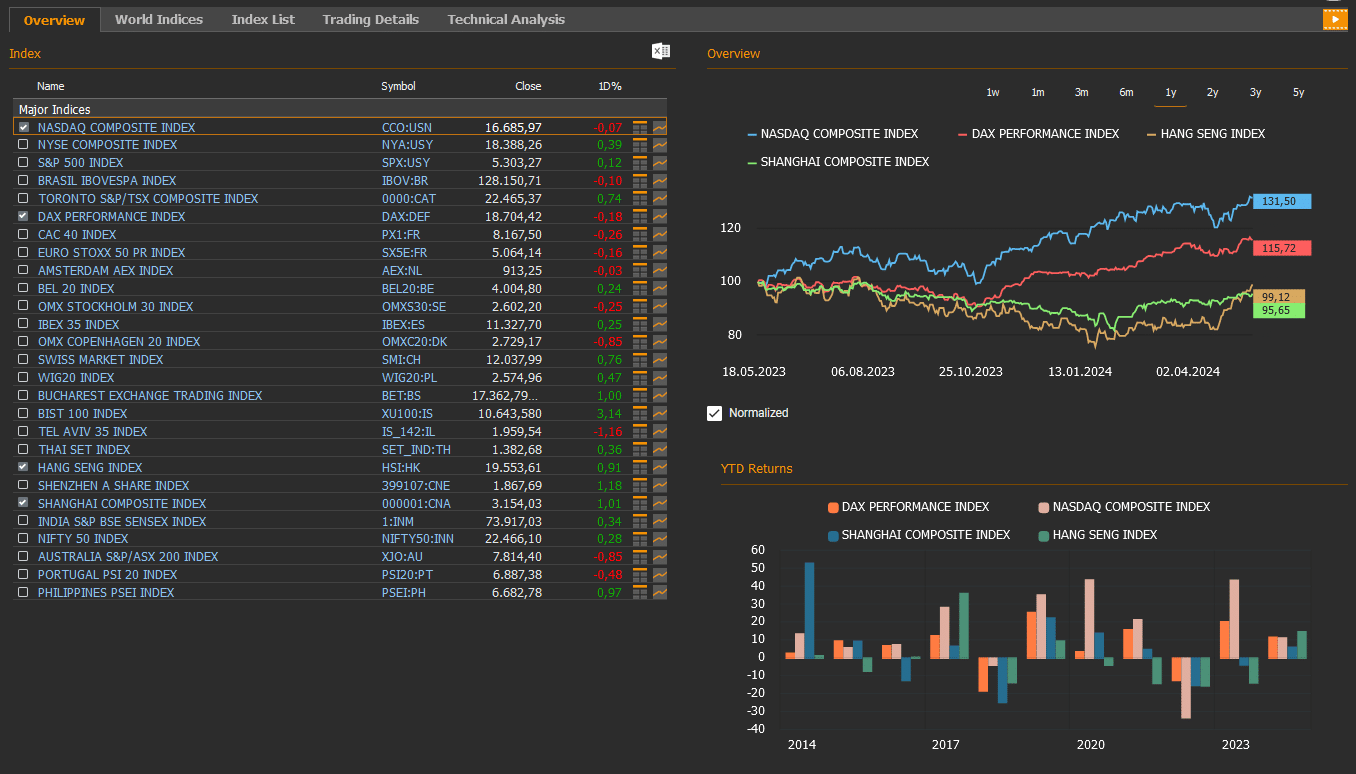Global Markets Recap

U.S. Markets:
- On Friday, amid ongoing uncertainty regarding the timing of Federal Reserve rate cuts and cautious remarks from several Fed members about potential rate reductions, Wall Street indices closed with mixed performances. The Nasdaq composite index (CCO:USN) closed flat at 16,685.97, the NYSE composite index (NYA:USY) rose by 0.39% to 18,388.26, the S&P 500 index (SPX:USY) rose by 0.12% to close at 5,303.27, and the Dow Jones Industrial Average Equal Weight index (DJIEW:USY) rose by 0.27% to 12,355.97.
- The Dollar Index (DXY), a closely watched gauge of the U.S. dollar’s performance against other major currencies, closed last week at 104.50 marking a 1% weekly loss.
- The Brent crude oil (LCO07:USC) closed the previous week at USD 83.98 per barrel, reflecting a 1% weekly gain.
- The price of gold (XAU/USD:USC) closed last week with a 2% gain, settling at USD 2,414.25 per ounce.
- The 10-year U.S. Treasury yield (USGG10YR:BND) completed the week with a 7.85 basis points loss, settling at 4.42%. The 2-year U.S. Treasury yield (USGG2YR:BND), particularly responsive to Federal Reserve policy rates, finished at 4.84% with a 3.7 basis points loss.
European Markets:
- European stocks mostly ended lower on Friday. The Stoxx Europe 600 index (SXXP:FR) closed down 0.13% to 522.94. The German DAX index (DAX:DEF) lost by 0.18% to 18,704.42, and the French CAC 40 index (PX1:FR) declined by 0.26% to 8,167.50.
Asian Markets:
- Stocks in the Asia-Pacific region mostly rose last Friday. The Hang Seng index (HSI:HK) rose by 0.91% to 19,553.61, while the Nikkei 225 index (100000018:JPT) lost by 0.34% to 38,787.38 and China’s Shanghai Composite index (000001:CNA) rose by 1% to 3,154.03.
- The S&P/ASX 200 Benchmark index (XJO:AU) in the Australian stock market closed down by 0.85% to 7,814.40.
Take the Guesswork out of Investing: Backtest Your Strategies with Ease!
Overview of Key Economic Indicators in the US
Let’s take a look at the macroeconomic indicators and developments tracked in the US last week:
- Industrial Production and Capacity Utilization
In the United States, data on April industrial production and capacity utilization rates were released. Industrial production slowed down in April, remaining flat (0% change) after a modest 0.1% increase in March, marking the lowest level in the past three months.
Capacity utilization slightly declined from 78.5% in March to 78.4% in April, contrary to expectations of remaining flat.
- Housing Market
Housing starts for April showed a partial recovery with a 5.7% increase in April after a 16.8% decline in March. However, building permits fell by 3% in April, following a 5% decline in March, marking the second consecutive month of decreases.
- Inflation Data
The headline Consumer Price Index (CPI) for April slowed to a 0.3% monthly increase, down from 0.4% in March and below the 0.4% expectation.
Annually, the CPI fell from 3.5% to 3.4%, the lowest level in four months. The significant increase in apparel prices in April limited the slowdown in monthly CPI.
Energy prices increased by 1.1%, similar to the previous month, while the growth rate of service prices slightly slowed from 0.5% to 0.4%, both remaining at high levels. Apparel prices saw a marked rise from 0.7% to 1.2%, exceeding the monthly headline CPI.
The headline Producer Price Index (PPI) rose by 0.5% in April, surpassing expectations of a 0.3% increase, following a 0.1% decline in March.
Annually, the PPI increased from 1.8% to 2.2%, the highest level in a year. The monthly increase in PPI was driven by a rebound in energy prices (from a 1.3% decline to a 2% increase) and service prices (from a 0.1% decline to a 0.6% increase). However, food prices fell again monthly (from a 0.4% increase to a 0.7% decrease), limiting the PPI rise.
The core PPI, which excludes food and energy prices, increased by 0.5% in April after a 0.1% decline in March, exceeding expectations of a 0.2% increase. Annually, the core PPI rose from 2.1% to 2.4%, the highest level in eight months.
- Retail Sales
Retail sales in April were flat (0% change) after a 0.6% increase in March, falling short of the 0.4% growth expectation. Core retail sales, which exclude automobiles, gasoline, food, and building materials, fell by 0.3% in April after a 1% increase in March, against expectations of a 0.1% increase. These figures indicate a slowdown in consumer spending and domestic demand.
Unleash Your Investment Potential. EquityRT might be the missing puzzle piece to reach your ultimate investment strategy.
U.S. Economic Data Highlights for the Week
In the United States, markets will focus on the release of the Federal Reserve’s May meeting minutes on Wednesday. These minutes are expected to provide more clues regarding the Fed’s future monetary policy and potential rate cuts.
Preliminary PMI data for May from S&P Global, which will signal the current state of economic activity, will be released on Thursday. The final PMI for the manufacturing sector in April was revised slightly upward from 49.9 to the 50 threshold, indicating a shift from contraction to a stable state in manufacturing. The services PMI for April was also revised up from 50.9 to 51.3, suggesting a slight acceleration in growth and marking the 15th consecutive month of expansion.
For May, preliminary data is expected to show the manufacturing PMI dropping back into contraction territory at 49.9, down from 50, while the services PMI is anticipated to rise slightly to 51.3, indicating a modest acceleration in growth.
The weekly initial jobless claims, will be monitored on Thursday. The most recent data showed a decrease from 232,000 to 222,000, signaling a tight labor market and remaining below historical averages.
On Friday, preliminary data for April durable goods orders will be released, providing insight into the production trend. Durable goods orders had increased by 0.7% in February and by 2.6% in March, marking two consecutive months of growth. However, preliminary data for April suggests a potential 0.7% decline in orders.
Also on Friday, the final May reading of the University of Michigan Consumer Confidence Index will be published. Preliminary data indicated a significant drop from 77.2 to 67.4, the lowest level in six months. The current conditions sub-index fell from 79 to 68.8, and the expectations sub-index declined from 76 to 66.5. Short-term inflation expectations rose from 3.2% to 3.5%, and long-term expectations increased from 3% to 3.1%, both reaching six-month highs.
Housing market data to be released includes April existing home sales on Wednesday and new home sales on Thursday.
Take the guesswork out of investing: Backtest your strategies with ease!
European Economic Outlook and Economic Events
- Eurozone Inflation Data
In Europe, key data influencing the ECB’s monetary policy included the final April CPI figures for the Eurozone. According to the report, the headline CPI in the Eurozone increased by 0.6% month-over-month in April, aligning with preliminary data, following a 0.8% rise in March. On a yearly basis, the CPI remained at 2.4% in April, maintaining its lowest level in the past five months.
The core CPI, which excludes volatile items, slightly decreased from 2.9% to 2.7% year-over-year in April, marking the lowest level since March 2022.
- Eurozone Industrial Production
Industrial production in the Eurozone rose by 0.6% month-over-month in March, exceeding expectations of a 0.4% increase, following a 1% rise in February. However, on an annual basis, the decline in industrial production slowed from 6.3% in February to 1% in March, marking the third consecutive month of contraction.
- Eurozone GDP Growth
Revised GDP growth figures for the first quarter of this year in the Eurozone were released. The economy grew by 0.3% quarter-over-quarter in Q1, consistent with preliminary estimates, indicating the strongest growth since Q3 2022. This growth marked a recovery from the mild recessions experienced in the previous two quarters, where the economy contracted by 0.1% each in both Q3 and Q4 of 2022. On a yearly basis, the growth rate increased from 0.1% to 0.4%.
Unleash Your Investment Potential. EquityRT might be the missing puzzle piece to reach your ultimate investment strategy.
Economic Indicators in Focus This Week in the European Region
On Tuesday, Germany’s April Producer Price Index (PPI) will be released. In Germany, the PPI fell by 0.4% month-over-month in February but increased by 0.2% in March. The annual decline in March slowed from 4.1% to 2.9%, marking the ninth consecutive month of decline. In April, the PPI is expected to rise by 0.3% month-over-month, with the annual decline rate slowing from 2.9% to 3.2%.
Additionally, the Eurozone’s trade balance data for March will be followed on the same day. In February, the trade surplus in the region rose from 11.6 billion euros to 23.6 billion euros, the highest level since December 2020. Details showed that monthly exports increased by 4.1%, while imports fell by 1.3%.
On Thursday, the HCOB preliminary PMI data for May, providing insights into the recent economic outlook across Europe, will be monitored. In April, manufacturing PMIs across the region indicated contraction due to tightened financial conditions and weak demand. However, service PMIs remained in the growth zone, above the 50 threshold.
On Wednesday, key data influencing the Bank of England’s monetary policy, the April Consumer Price Index (CPI) for the UK, will be tracked. In March, the UK’s headline CPI increased by 0.6% month-over-month, similar to the previous month and above expectations. Annually, it slightly slowed from 3.4% to 3.2%, the lowest level since September 2021, with expectations for a slowdown to 3.1%. Core CPI in the UK also increased by 0.6% month-over-month in March, exceeding expectations. Annually, it slowed from 4.5% to 4.2%, the lowest level since December 2021, with expectations for a slowdown to 4.1%.
On Thursday, the preliminary consumer confidence index for May in the Eurozone will be followed. In April, the consumer confidence index improved slightly from -14.9 to -14.7, reaching the highest level since February 2022, though it remained in the negative territory.
On Friday, Germany’s final GDP growth data for the first quarter of the year will be monitored. According to preliminary data, the German economy grew by 0.2% quarter-over-quarter in Q1, showing partial recovery and exceeding expectations of 0.1%, after a 0.5% contraction in the last quarter of the previous year. Annually, it contracted by 0.2%, similar to the previous quarter.
Take the guesswork out of investing: Backtest your strategies with ease!
Upcoming Economic Highlights Across Asia-Pacific
In April, China’s industrial production growth accelerated from 4.5% to 6.7% year-on-year, surpassing expectations of a 5.5% increase. However, retail sales growth, an indicator of domestic demand, slowed from 3.1% to 2.3%, falling short of the anticipated 3.8% increase and signaling weakening domestic demand.
Fixed asset investment growth also decelerated slightly from 4.5% to 4.2%, below the expected 4.6% increase. Real estate investment contracted by 9.8%, highlighting ongoing issues in the housing sector.
New home prices in China declined by 3.1% year-on-year in April 2024, a steeper decline than the 2.2% fall in the previous month. This marked the tenth consecutive month of decrease and the fastest pace since July 2015.
The People’s Bank of China (PBoC) maintained the one-year loan prime rate (LPR) at 3.45%, a benchmark for short-term loans, and kept the five-year LPR, a benchmark for long-term loans such as mortgages, steady at 3.95%.
On Wednesday, the Reserve Bank of New Zealand and on Thursday, the Bank of Korea will hold their monetay policy meetings. The Reserve Bank of New Zealand is expected to keep its policy rate unchanged. Similarly, the Bank of Korea, which kept its policy rate steady at 3.50% for the tenth consecutive month in its April meeting, is also expected to maintain the rate at this week’s meeting.
Other key indicators to be monitored from Asia include Indonesia’s interest rate decision and first-quarter current account balance, May’s flash PMI data for Japan’s manufacturing and services sectors, and India’s weekly foreign exchange reserves.
